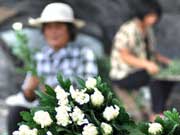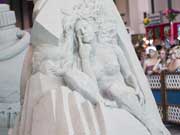 |
| The avalry horse teams of the second battalion of cavalry under the Inner Mongolia Military Area Command (MAC) of the Chinese People's Liberation Army (PLA).(China Military Online) |
On the famous Xilin Gol prairie, herds of horses gallop on the grass. On August 4, reporters watched riders of the second battalion of cavalry under the Inner Mongolia Military Area Command (MAC) of the Chinese People's Liberation Army (PLA) undergo training.
As the Cavalry dashed freely across the vast grasslands, they showed wonderful skills - riding, shooting, and leaping over obstacles.
The ancient forces of the cavalry date back to the Warring States period, and flourished during the Yuan Dynasty. The wonderful displays of this modern cavalry battalion seemed to evoke the splendor of battlefields of bygone days.
On the Xilin Gol prairie, the cavalry have always been a fixture. However, as modern warfare has turned to mechanization and information technology to replace mules and horses, the brilliance of the cavalry gradually dims. In 1985, in accordance with the demobilization strategy of the Central Military Commission, the cavalry disappeared as an armed force. The army retained only two symbolic cavalry battalions and a few troops of cavalry. Cavalry No.2 camp is one of them.
In 2011 Xilin Gol League was categorized as the "capital of horses" by the China Horse Industry Association. The horses of cavalry No.2 camp – impervious to heat and cold alike, and renowned for their stamina – are a fitting symbol of the "capital of horses", and their startling performances act as a magnet for visitors. But they represent much more than a courtesy salute to the past.
In the winter of 2010, snowstorms struck the Xilin Gol prairie, and transportation and communications were affected over a large area. One hundred herders trapped in the snow were in desperate need of rescue. In order to delivered rapid relief to the affected areas, the six cavalry horse teams of the No.2 battalion were pressed into service, bringing hope and warmth to the victims. They were affectionately known as "the saviors on horseback".
Will traditional cavalry fade from the stage of history?
On the training ground of the cavalry No.2 camp, Mr. Li Yihui, an expert in Combat Theory and Doctrine Research Department from the Academy of Military Sciences, researches new cavalry tactics under modern conditions of warfare together with the military commander Xie Weihua and the cavalry camp cadres. Li Yihui says: "Even in the information age, the status and role of our army cavalry cannot be dismissed. Kitted out with a Beidou handset, cavalry can utilize information technology, conduct intelligence reconnaissance, and act as artillery spotters.”
 |

 World in photos: (Aug.12-Aug.18)
World in photos: (Aug.12-Aug.18) In pictures: Damaged road in rainstorm-hit Jinxiu County
In pictures: Damaged road in rainstorm-hit Jinxiu County Enjoy mums of early autumn days in Shandong
Enjoy mums of early autumn days in Shandong Singapore Night Festival opens
Singapore Night Festival opens Persistent downpours cause worst floods since 1998 in N China
Persistent downpours cause worst floods since 1998 in N China 2013 Taiwan Stamp Exhibition opens to public in Taipei
2013 Taiwan Stamp Exhibition opens to public in Taipei 4th Int'l Sand Sculpting Exhibition held in Canada
4th Int'l Sand Sculpting Exhibition held in Canada Villages flooded due to embankment breach on Heilong River
Villages flooded due to embankment breach on Heilong River Jeremy Lin meets fans in Shanghai, receives birthday cake
Jeremy Lin meets fans in Shanghai, receives birthday cake
Day|Week|Month